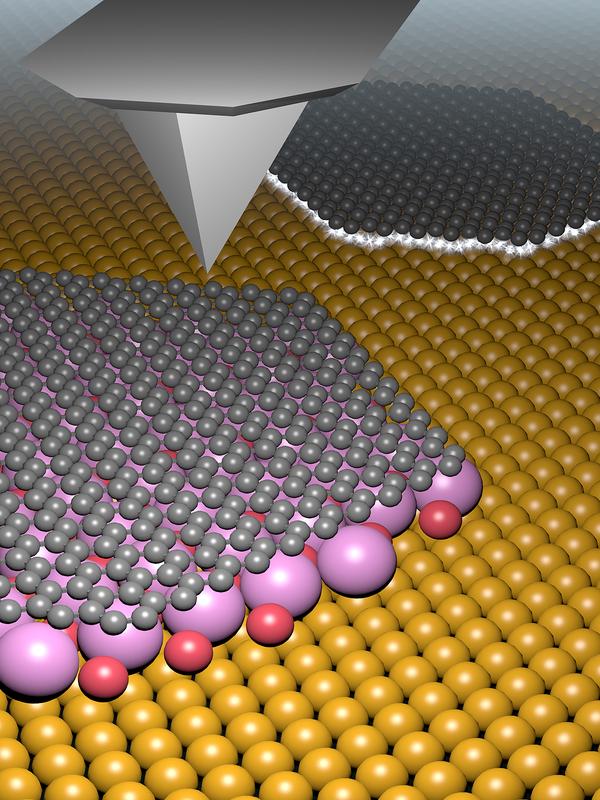Decoupled graphene thanks to potassium bromide

Potassium bromide molecules (pink) arrange themselves between the copper substrate (yellow) and the graphene layer (gray). This brings about electrical decoupling. © Department of Physics, University of Basel
Graphene consists of a layer of carbon atoms just one atom in thickness in a honeycomb pattern and is the subject of intensive worldwide research.
Thanks to its high level of flexibility, combined with excellent stability and electrical conductivity, graphene has numerous promising applications – particularly in electronic components.
Molecules for decoupling
Graphene is often produced via a chemical reaction on metallic surfaces in a process known as chemical vapor deposition. The graphene layer and the underlying metal are then electrically coupled, which diminishes some of the special electrical properties of graphene.
For use in electronics, the graphene has to be transferred onto insulating substrates in a multistep process, during which there is a risk of damage and contamination.
In order to obtain defect-free, pure graphene, it is therefore preferable to decouple the graphene electrically from the metallic substrate and to develop a method that allows easier transfer without damage.
The group led by Professor Ernst Meyer from the Department of Physics and the Swiss Nanoscience Institute (SNI) of the University of Basel is investigating ways of incorporating molecules between the graphene layer and the substrate after the chemical deposition process, which leads to this type of decoupling.
Altering electrical properties
In a study carried out by SNI doctoral student Mathias Schulzendorf, scientists have shown that potassium bromide is ideally suited to this. Potassium bromide is a soluble hydrogen bromide salt.
Unlike the chemically similar compound sodium chloride, potassium bromide molecules arrange themselves between the graphene layer and the copper substrate. This was demonstrated by researchers in a variety of scanning probe microscopy studies.
Calculations performed by colleagues at the University of Modena and Reggio Emilia (Italy) explain this phenomenon: It is more energetically advantageous for the system if potassium bromide molecules arrange themselves between the graphene and copper than if they are deposited on the graphene – as happens with sodium chloride.
The researchers have shown that the intermediate layer of potassium bromide alters the electrical properties of graphene – until they correspond to those expected for free graphene.
“Our work has demonstrated that the graphene and the underlying metal can be decoupled using potassium bromide, bringing us a key step closer to producing clean and defect-free graphene,” says project supervisor Dr. Thilo Glatzel, who is a member of Meyer’s team.
Dr. Thilo Glatzel, University of Basel, Department of Physics, Tel. +41 61 207 37 30, Email: thilo.glatzel@unibas.ch
Mathias Schulzendorf, Antoine Hinaut, Marcin Kisiel, Res Jöhr, Rémy Pawlak, Paolo Restuccia, Ernst Meyer, Maria Clelia Righi, and Thilo Glatzel
Altering the Properties of Graphene on Cu(111) by Intercalation of Potassium Bromide
ACS Nano (2019), doi: 10.1021/acsnano.9b00278
Media Contact
More Information:
http://www.unibas.chAll latest news from the category: Physics and Astronomy
This area deals with the fundamental laws and building blocks of nature and how they interact, the properties and the behavior of matter, and research into space and time and their structures.
innovations-report provides in-depth reports and articles on subjects such as astrophysics, laser technologies, nuclear, quantum, particle and solid-state physics, nanotechnologies, planetary research and findings (Mars, Venus) and developments related to the Hubble Telescope.
Newest articles

NASA: Mystery of life’s handedness deepens
The mystery of why life uses molecules with specific orientations has deepened with a NASA-funded discovery that RNA — a key molecule thought to have potentially held the instructions for…

What are the effects of historic lithium mining on water quality?
Study reveals low levels of common contaminants but high levels of other elements in waters associated with an abandoned lithium mine. Lithium ore and mining waste from a historic lithium…

Quantum-inspired design boosts efficiency of heat-to-electricity conversion
Rice engineers take unconventional route to improving thermophotovoltaic systems. Researchers at Rice University have found a new way to improve a key element of thermophotovoltaic (TPV) systems, which convert heat…



